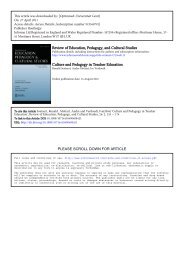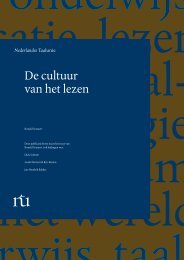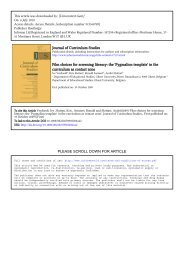a view informed by the problems of traditional literacy in a digital age
a view informed by the problems of traditional literacy in a digital age
a view informed by the problems of traditional literacy in a digital age
You also want an ePaper? Increase the reach of your titles
YUMPU automatically turns print PDFs into web optimized ePapers that Google loves.
Downloaded <strong>by</strong> [University <strong>of</strong> Gent] at 06:46 09 December 2011<br />
Ronald Soetaert & Bart Bonamie<br />
than words; im<strong>age</strong>s, graphics and sounds can play an important role. New<br />
<strong>in</strong>terface design will change <strong>the</strong> writ<strong>in</strong>g space. Today, this <strong>in</strong>teraction is<br />
ma<strong>in</strong>ly text based.<br />
Indeed, historically, <strong>the</strong> <strong>in</strong>teractive role was fulfilled <strong>by</strong> spoken<br />
langu<strong>age</strong>, whereas written langu<strong>age</strong> was a better medium for reflection,<br />
ongo<strong>in</strong>g <strong>in</strong>terpretation and evaluation. Pr<strong>in</strong>ted texts could be read over and<br />
over aga<strong>in</strong>. The literary canon and <strong>the</strong> whole critical tradition built around it<br />
were a direct result <strong>of</strong> <strong>the</strong> <strong>in</strong>vention <strong>of</strong> book pr<strong>in</strong>t<strong>in</strong>g, which created a<br />
revolution <strong>in</strong> <strong>the</strong> production and reception <strong>of</strong> knowledge, <strong>in</strong> <strong>the</strong> way we<br />
organise society and <strong>the</strong> way we use our bra<strong>in</strong>s.<br />
It is possible that multimedia free us from a particular form <strong>of</strong> written<br />
<strong>literacy</strong>. So <strong>in</strong> fact hypermedia could br<strong>in</strong>g toge<strong>the</strong>r on <strong>the</strong> screen what <strong>the</strong><br />
pr<strong>in</strong>t<strong>in</strong>g press has separated. Jo<strong>in</strong><strong>in</strong>g an electronic community, <strong>in</strong> which<br />
audio and visual aspects become as important as written words and <strong>in</strong> which<br />
design plays a central role, confronts us with a fundamental question: What<br />
do we w<strong>in</strong>? Or what do we lose?<br />
In any case, we have a moral obligation to prepare children to critically<br />
<strong>in</strong>terpret and evaluate visual and audio <strong>in</strong>formation from our dom<strong>in</strong>ant<br />
culture, and to provide critical <strong>in</strong>terpretative models to deal with visual<br />
<strong>in</strong>formation. Indeed, very <strong>of</strong>ten <strong>in</strong> <strong>traditional</strong> education: ‘Our visual<br />
acculturation start<strong>in</strong>g with Sesame Street usually stops at <strong>the</strong> classroom<br />
door’ (LaSp<strong>in</strong>a, 1998, p. xiv). We can only hope to avoid <strong>the</strong> same<br />
happen<strong>in</strong>g with modern technology. It is a complex process because we are<br />
<strong>in</strong> <strong>the</strong> middle <strong>of</strong> a revolution, creat<strong>in</strong>g new genres and products; our whole<br />
work is ‘under development’ or ‘work <strong>in</strong> progress’.<br />
Methodology<br />
As far as <strong>the</strong> teach<strong>in</strong>g <strong>of</strong> langu<strong>age</strong>s is concerned, back-to-basics can be<br />
characterised <strong>by</strong> <strong>the</strong> fact that grammar and literature are at <strong>the</strong> core <strong>of</strong> our<br />
subject. In fact, <strong>in</strong> modern langu<strong>age</strong>s <strong>the</strong> curriculum and <strong>the</strong> methodology<br />
<strong>of</strong> Lat<strong>in</strong> and Greek were imitated: study<strong>in</strong>g grammar and vocabulary <strong>in</strong><br />
order to read/translate <strong>the</strong> classical texts. Such a classical education was<br />
essential to become a member <strong>of</strong> <strong>the</strong> cultural elite. Very <strong>of</strong>ten langu<strong>age</strong><br />
teach<strong>in</strong>g was part <strong>of</strong> <strong>the</strong> construction <strong>of</strong> a national identity. It focused on <strong>the</strong><br />
standard langu<strong>age</strong> and <strong>the</strong> literary canon.<br />
As part <strong>of</strong> a general progressive reform <strong>of</strong> education, <strong>the</strong><br />
communicative approach to langu<strong>age</strong> teach<strong>in</strong>g was <strong>in</strong>troduced. Content –<br />
and certa<strong>in</strong>ly literature – was considered less important. Skills were at <strong>the</strong><br />
core <strong>of</strong> <strong>the</strong> methodology; <strong>the</strong> aim was to use langu<strong>age</strong> <strong>in</strong> ‘real<br />
communicative sett<strong>in</strong>gs’. The approach stressed learner-centredness and<br />
motivation.<br />
As we have noted, back-to-basics criticism was based on <strong>the</strong> idea that<br />
our culture could be characterised <strong>by</strong> a general amnesia. The weak po<strong>in</strong>t <strong>in</strong><br />
138





